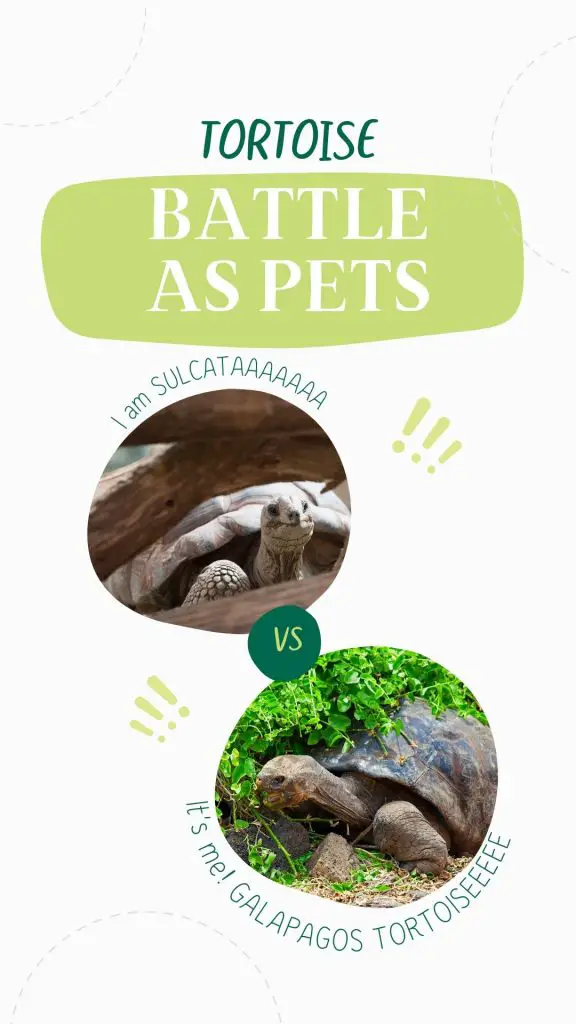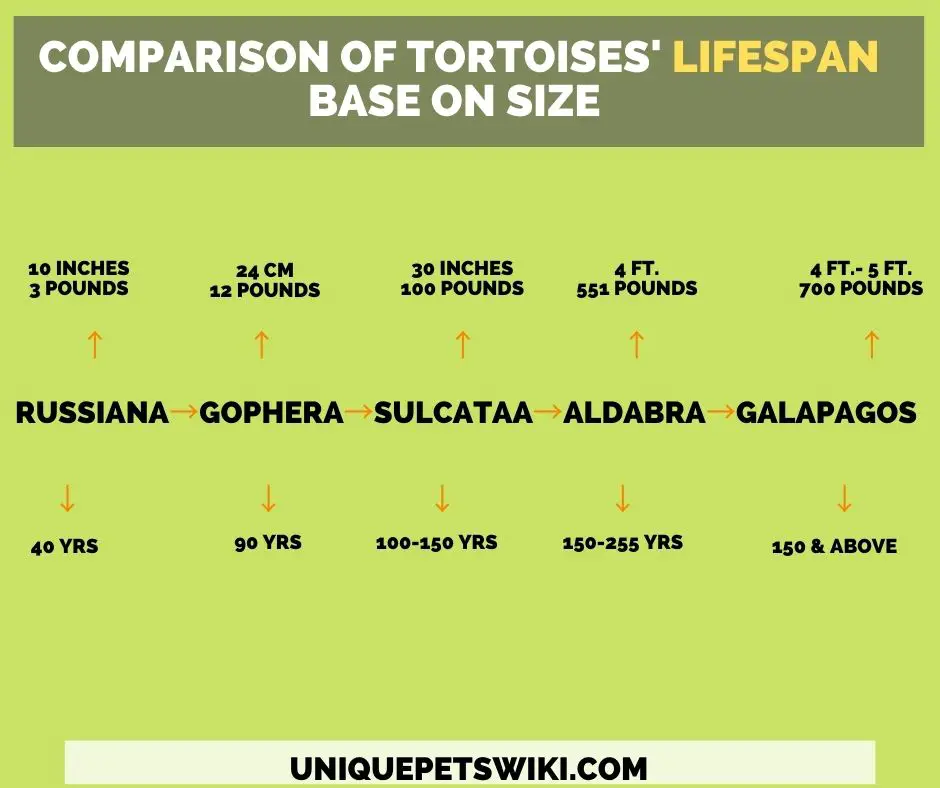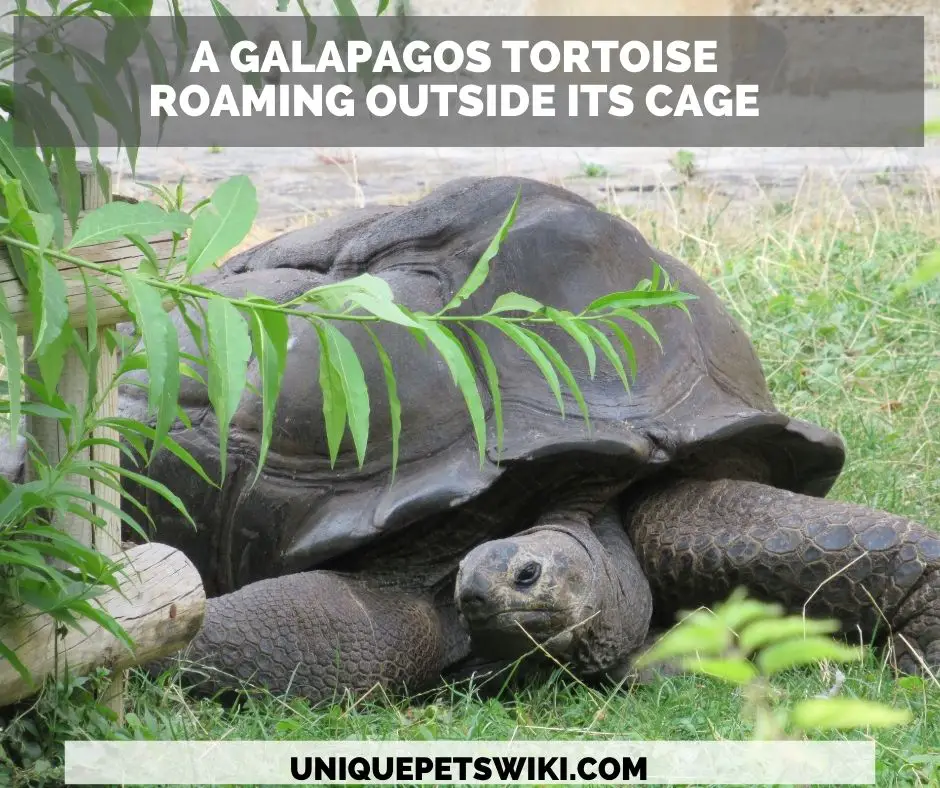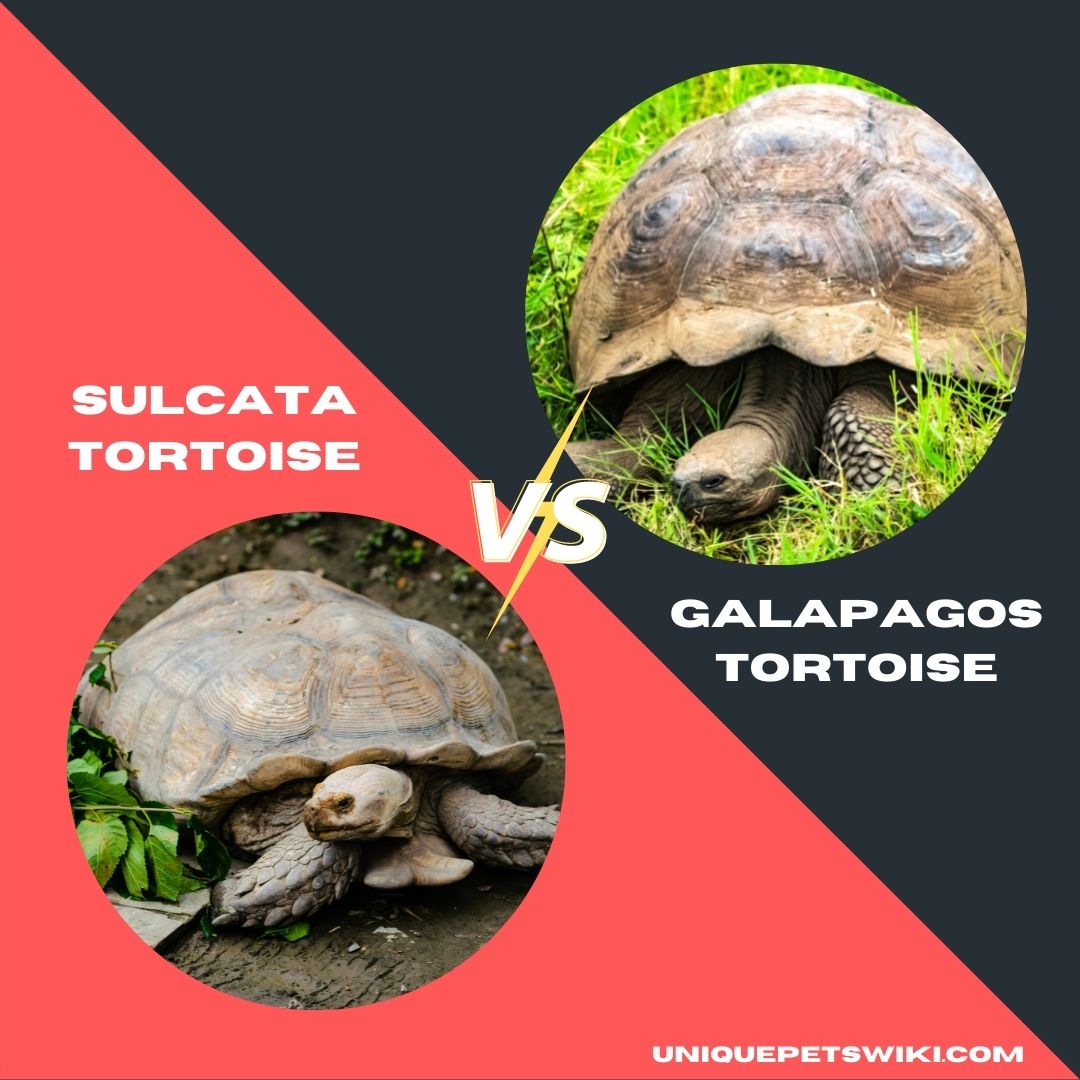When they are huge, measuring over 1 meter (3.3 ft.) long and weighing over 500 pounds, we call them giant tortoises. The Galapagos giant tortoises fall in that category. Galapagos tortoises aren’t just one species of the giant tortoises but the biggest ever known.
Do you think they would make good pets despite their size? Between sulcata and Galapagos tortoises, which species is ideal for a pet?
Relax! This article promises to answer these questions and clarify your doubts about what both sulcata and Galapagos tortoises are and what they’re not.
After reading this article, you’ll have as much information that you need on their personality and care to help you make a good decision of which species to get as a pet.
Let’s delve into the topic in detail.
Contents
Sulcata vs Galapagos Tortoise As Pets
These two species of tortoises, sulcata and Galapagos live on land and are not only strict herbivores but heavy eaters. They’re both known to be docile, calm, friendly, active, and hardy. These unique personalities are quite opposing to their huge and heavy size.
While it is easy to own sulcata as a pet despite its large size, Galapagos tortoises are protected species because they’re listed as vulnerable in IUCN. And except you have the license to keep one you cannot keep a Galapagos tortoise.
But looking at the size, are they species worth going through the stress for? Maybe not. Note that You Can Keep a Galapagos tortoise Only If You Get The Legal Rights To Keep One.
However, these species of tortoises are bigger in size than sulcata and weigh heavier as well. This implies that handling them once they get to adult sizes will be a herculean task.
Besides, caring for a giant tortoise such as Galapagos as a pet requires investment both in time and money. And also in providing a comfortable habitat.
Whereas adult sulcata tortoises measuring only about 30 inches are still in the size you can manage. Once they get to adult size within 2 – 12 years, you’ll need to provide them a large and strong outdoor enclosure.
In a nutshell, sulcata makes better pets than Galapagos tortoises. For one reason, their large but manageable sizes and not having to get a license to keep one.
Sulcata vs Galapagos Tortoise: Full Comparison

A lot of factors are usually taken into consideration when choosing a pet animal. A few of such factors include easy care requirements, manageable size, moderate or long lifespan, low maintenance cost, and good disposition.
Herpetologists especially beginners often go for pets they know they can care for with ease and within a budget. If you’re in this category, then sulcata tortoises will be ideal for you.
On the flip side, though Galapagos tortoises are docile and long-lived, they are likely to outlive you because they have a long lifespan of over 150 years. Also, they’re not cheap to maintain as they eat like cows.
That said, what does it take to keep any of these species of tortoises? Let’s find out together.
Lifespan
Before going further, it is important to mention that the bigger in size a tortoise is, the longer it can live. This explains why a sulcata tortoise will live longer than a Russian tortoise, as an Aldabra giant tortoise will live longer than a sulcata tortoise.
Similarly, Galapagos giant tortoises have a longer lifespan than sulcata tortoises. Perhaps, there’s something about their genes, but science is yet to prove. Sulcata tortoises can live long but not as long as Galapagos giant tortoises.
On average, sulcata tortoises have a lifespan of 100 years. The longest they can live both in the wild and in captivity. That is a lot of years for a companion to have around.
On the contrary, Galapagos giant tortoises can live even more. Because of their long lifespan, they’re likely to outlive the owner. They can live for as long as 150 years.
Therefore, if you’re looking forward to a pet that can live over 150 years, the Galapagos tortoise is worth a trial as long as you’re permitted to keep one.
However, if you need a long-lived pet but with a manageable size when it becomes an adult, then sulcata tortoise is a good fit for you.

Habitat
The island of Galapagos in Ecuador, the northern part of South America gets its name after these giant tortoises because of their abundant supply in the island. Interestingly, Galapagos giant tortoises are only found on this island and nowhere else in the world.
In this region, they are known to live and wallow in muddy puddles usually in sunny areas, and take a rest underneath large rocks. During rainy seasons, they occupy the lowlands and return to the cooler highlands during hot and dry seasons.
With this in mind, if you’re to keep them in captivity, you’re to house them in an outdoor enclosure to ensure that their muddy natural habitat is provided.
Unlike Galapagos, sulcata tortoises are native to the southern part of the Sahara desert. This includes Senegal, Mauritania, Chad, Sudan, Niger, and Mali.
Being native to hot arid deserts, they are exposed to harsh weather conditions and can withstand extreme (hot) temperatures in captivity. Hence, while setting up their habitat, ensure to simulate this in their enclosure.
Moreover, one thing you should keep in mind while setting up an enclosure for your pet sulcata tortoise is its large size. These tortoises have the fastest growth rate and within the space of two years, they would grow so big and need an outdoor enclosure.
On that note, the size of their enclosure will have to be increased. Basically, what you would need to set up their habitat include:
- A Sizeable Enclosure: This will depend on the size of your tortoise, an adult sulcata tortoise will do well in an 80 ft. tank that has lots of floor space and strong walls to withstand digging.
Hatchlings can be housed in an 18 x 18 x 12 (18 inches long, 18 inches wide, and 12 inches tall).
- Plants and some rocks.
- Substrates: The best substrates for sulcata tortoises should be a mixture of different types of substrates. The substrates shouldn’t be compressed together to encourage digging and must not be loose to avoid impaction.
Also, to ensure that no room is given for bacteria to breed, keep the substrates clean and dry at all times.
For detailed information on the ideal habitat set up for sulcata tortoises of all ages read about their habitat.
Size
All creatures including large plants started small. The fact is, they don’t stay small forever. At a certain age/stage, they’ll get big and will need some space out of the reach of humans.
As hatchlings, both sulcata and Galapagos tortoises can be housed indoors. However, once they become big, they’ll need an open space outside the house to offer them enough space to roam.
This is because they are large and heavy as adults. Sulcata tortoises measure about 30 inches and weigh over 100 pounds. On the flip side, Galapagos tortoises measure between 4ft. – 5ft. and weigh over 700 pounds.
Weight
As stated earlier, sulcata tortoises weigh about 100 pounds on average while Galapagos tortoises weigh between 475 pounds to 700 pounds.
In rare cases, sulcata tortoises have been reported to weigh up to 150 pounds and above in captivity. With this size, it’s difficult to handle (carry) any of these species of tortoises as they are typically very heavy.
Looks
Physically, all tortoises look almost the same. They all have the same physical features such as rough skin, domed shell, and thick stubby legs.
With all these similarities almost in everything, it can be difficult to tell between sulcata and Galapagos species. Especially if you are a beginner herpetologist.
Nonetheless, one thing to note is that no matter how close two different species of tortoise may resemble each other, they both have different shell color, length of neck and legs, and even shape of the shell.
That said, Galapagos giant tortoises range in color from light brown to light green. A unique color that helps them blend in with their environment.
On the other hand, sulcata tortoises have brown, broad, and oval carapace with large scales known as scutes. Sulcata tortoises also have thick and golden brown color skin which is quite different from the skin color of Galapagos tortoises.

Active Levels
If you have your Galapagos tortoise run against sulcata tortoise in a race competition, you shouldn’t be surprised if the sulcata tortoise outran your Galapagos giant tortoise.
These giant tortoises are very slow in movement as compared to other species such as sulcata. They move at an incredible speed of about 0.16 mph (0.26 km/h).
Apart from being slow in movement, their lifestyle revolves around eating, wallowing in puddles or relaxing in the sun, and burrowing. They’re not known to dig long tunnels like sulcata.
On the contrary, sulcata tortoises are equally big in size but are very active. They naturally enjoy moving around and digging. Because they can move heavy objects and dig long tunnels in their enclosure, they’re given the name “living bulldozers”.
If you’re permitted to keep a Galapagos giant tortoise, you shouldn’t worry about it digging and destroying some of your property. However, your sulcata will need not just a big enclosure but a strong one that your tortoise can not dig through.
Diet
Both sulcata and Galapagos tortoises are strict herbivores. This means that they only feed on a variety of grasses, leaves, fruits, cacti, and vines. Since they are found in different environments, the species of grasses, plant leaves and fruits they feed on will vary.
Sulcata tortoises that are desert-dwelling feed on grasses that are rich in fiber but low in protein. This is because their fiber-rich foods provide them all the nutrients that they need, including water.
Galapagos giant tortoises also get water from their foods. Because they have a slow metabolism, they can go many months without food and water.
Brumation
Many species of tortoises do not brumate. This is the case of sulcata and Galapagos giant tortoises. They only slow down their metabolism to cope with the cold winter months but will not completely hibernate.
While Galapagos giant tortoises will make use of caves underneath rocks to rest, sulcata tortoises will hide in their burrows for as long as the weather isn’t favorable.
When their metabolism is slowed down to almost zero, they’ll not eat because digestion at that period will be a problem. Therefore, if you’re to keep any of these species as pets, do not brumate them.
Don’t also force them into brumation by dropping the temperature in their cage. They might die if forced to brumate.
Personality
Generally, both sulcata and Galapagos giant tortoises have a calm and friendly personality. However, your tortoise may differ. This happens even to individual tortoises of the same species. The difference may be in their reaction when handled or activity level.
Galapagos giant tortoises aren’t known to be aggressive but sulcata tortoises are prone to aggression, especially the males. Gravid and nesting sulcata females also tend to be aggressive if they perceive any threat to their eggs.
Because of the likelihood for male sulcata to behave aggressively towards one another, it’s advisable you keep them separate.
Required Enclosure Size
To keep a sulcata tortoise, you must be prepared to construct a new enclosure almost every two years till it stops growing at about 15 years of age. As adults, sulcata tortoises need bigger enclosures of about 80 ft2 to keep them indoors.
Outdoor enclosures will be bigger than that. Hatchlings and juvenile sulcatas can be housed in an enclosure size of 18 x 18 x 12.
Lighting, Heating, Humidity Requirements
Much information isn’t available on temperature requirements for captive Galapagos giant tortoises. But going by their habitat, they thrive in temperate and tropical climates.
Similarly, their captive environment must be made to simulate their muddy tropical and temperate wild environments.
Whereas, sulcata tortoises being desert dwellers need a warm enclosure to thrive. They require a temperature range of 77⁰ F– 95⁰ F during the day, a basking spot temperature of not higher than 122⁰ F, and a nighttime temperature of not lower than 63⁰ F.
Suitability For Beginners
Although these two species of tortoises are huge in size, they both make great pets for beginners. They make good pets in the sense that they are easy to care for, easy to bond with, and less susceptible to diseases.
The only thing you’ll need to worry about is getting legal permission to own a Galapagos species because of its vulnerable/endangered status.
Cost
Galapagos giant tortoise isn’t readily available in the market. If you eventually see one, you’ll pay through your nose to get it. Younger ones of these animals cost between 4,000 USD to 9,500 USD to get. Adult Galapagos cost between 20,000 USD up to 60,000 USD.
Nonetheless, this price will vary depending on where you buy it from.
On the contrary, sulcata tortoises don’t cost that much to buy. They cost between 50 USD to 1000 USD. Setting up their habitat for the first time isn’t also an exorbitant cost. This will cost you approximately 300 USD.
Altogether, you’ll spend about 1500 USD to 2000 USD to buy and set up a sulcata tortoise for the first time.
Ability To Keep In Groups
From what we know about their personalities, Galapagos giant tortoises can stay in groups without any confrontation, but sulcata will need some privacy.
If you can’t provide all your sulcata tortoise separate enclosure, ensure that you make the one enclosure spacious enough to accommodate them.
Can You Keep Sulcata And Galapagos Giant Tortoise Together?
Galapagos giant tortoises can be kept in groups. In fact, they are kept in groups in zoos. But if you intend to keep both species together in one enclosure, you might need to reconsider your choice.
Keep in mind that sulcata tortoises are prone to aggression. Therefore, they may endanger the lives of Galapagos tortoises. The best way to keep these two species as pets is to get them separate enclosures with all requirements set to standard.
Wrapping Up
How interesting can it be to have a mini zoo in your home where family and friends love to spend some time around your lovely pets? But can you manage their large size till they grow old?
This is usually the problem. Nonetheless, if you have lots of space in your yard, then it’s possible. Many owners who pick up these animals as hatchlings or juveniles with little or no knowledge of their large size often end up sending these animals back to the wild.
Keep in mind that, it’s less risky to domesticate a wild-caught tortoise than it is for a captive breed to survive in the wild. The animal may die.
Thus, while it is easy to care for these animals, ensure you make provisions for their big size so that you can still keep them when they get big.
However, if their largeness in size will be a problem in the future, we advise that you check out other species of tortoises HERE.
